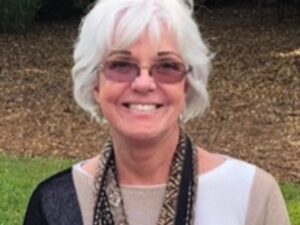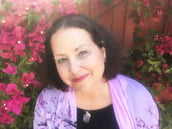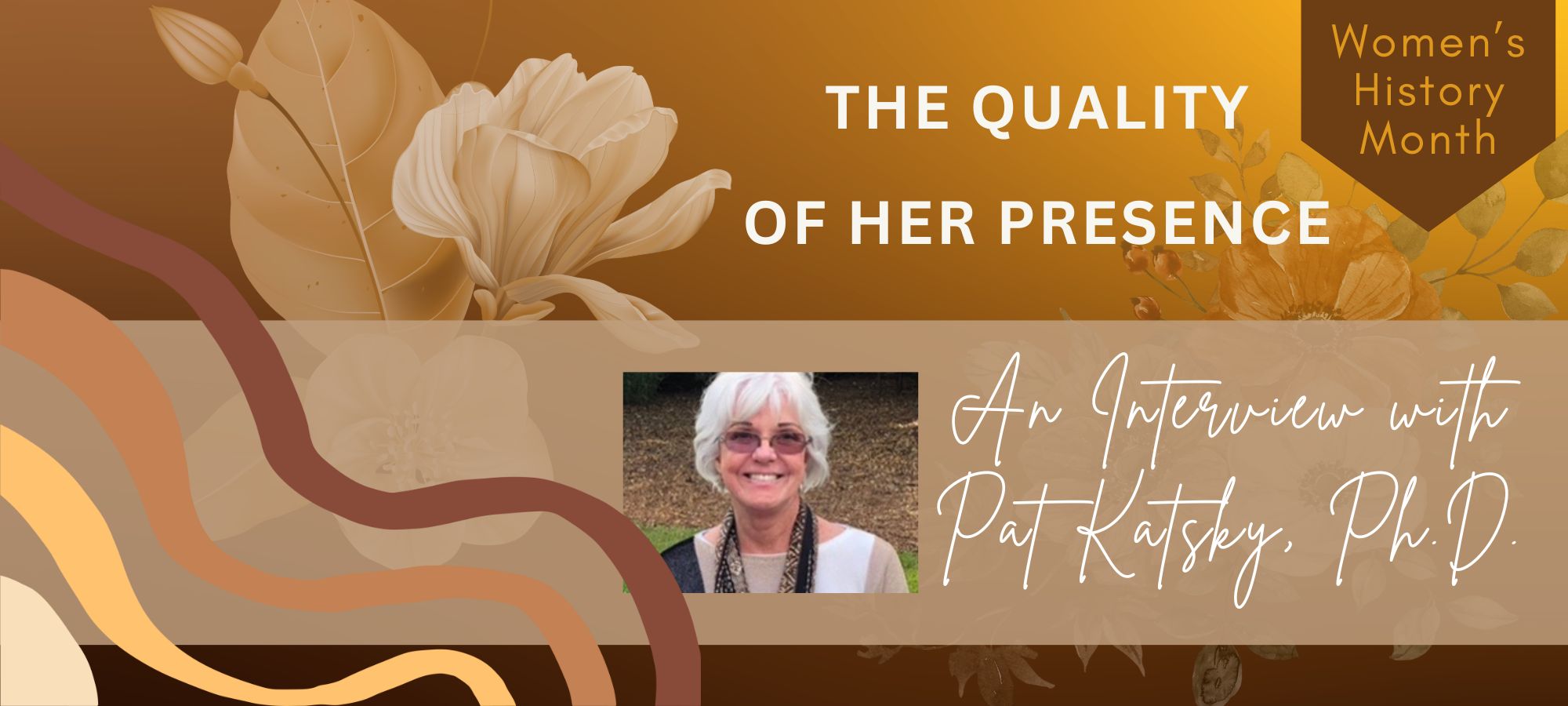Patricia O. Katsky is a core faculty member of the Specialization in Integrative Therapy and Healing Practices and was formerly provost at Pacifica. I’m delighted to speak with her about her experiences in becoming a therapist and also about her years of service at Pacifica.
Angela: Thank you for speaking with me today, Pat. You began your career with a Ph.D. in Sociology, complemented by a post-doc in clinical psychology. You’ve been a psychotherapist in private practice for many years. What drew you to become a Jungian analyst?
Pat: At mid-life, I found myself with a wonderful job on the faculty of the UCLA Anderson School of Management, and yet there was something in me that was not content. I started having disturbing dreams about driving off the road or driving in the wrong direction on the freeway, and I realized I needed to look at my life. These concerns led me to Jungian analysis. As I contemplated making significant life changes, a therapist friend unexpectedly decided to retire and asked if I would be interested in taking over her clinical practice. I took the leap, moving away from a secure position at UCLA in order to strike out on my own as a full-time psychotherapist, and found that I was more in alignment with what was my true direction.
After a couple of years, I decided to begin training as a Jungian analyst. I had experienced other kinds of psychodynamic therapy, but I found them lacking in respect for the psyche. The Jungian approach holds that there is wisdom in the psyche and that each individual’s path will be different as a result of coming into contact with deep inner knowing, learning to listen to what comes from below the surface. I found the Jungian approach helped me to orient myself and figure out the direction I wanted my life to take, and I found it was helpful to those in my practice as well.
Angela: March is Women’s History Month, and we’re celebrating women who have been trailblazers in depth psychology. In asking the faculty who their mentors or heroes are, we’ve so far heard of Marie-Louise von Franz, Clarissa Pinkola Estés, Carol Christ, and even Pacifica’s own Susan Rowland. But there are many others. Among your mentors and heroines, who has most influenced you as a psychologist?
Pat: That’s a great question. Overall, the interesting thing to me about women Jungian analysts and depth psychologists is the quality of their presence. It isn’t necessarily their writing, it’s that you feel something when you’re with them that’s hard to describe—an openness to life, the psyche, and the present moment. Two of the women I appreciate in this way are Jungian analysts Joan Chodorow and Tina Stromsted, who are both connected to the somatic world as authentic movement practitioners. They draw soul, body, and spirit together in their work. I also was influenced by a woman named Lore Zeller, who was the wife of one of the founders of the Los Angeles Jung Institute. She and her husband were living in Germany in the 1930s and were Jewish. They had the great good fortune to secure two of the limited number of tickets available on one of the few passenger ships leaving Germany (with these hard-to-obtain tickets, Jews were able to leave Germany and migrate to another country). However, the Nazis arrested and imprisoned her husband before their boat was due to sail. As a young woman, Lore had the guts to walk up alone to the doors of the concentration camp where her husband was imprisoned and ask that he be released—knowing very well that there was a strong possibility that she would be imprisoned herself for doing this. But as it happened, the Nazis did release him, and the young couple were able to leave Germany and immigrate to Los Angeles. I have such enormous respect for Lore. She worked in the institute’s bookstore and had the uncanny ability to suggest to those of us in analytic training just the right book to read next. I thought of her as my spiritual mother.
Another group of women who have been important to me are former Pacifica faculty members like Christine Downing and Ginette Paris who brought a depth psychological perspective to the study of Greek mythology. In addition, I’ve been inspired by Mary Watkins, also formerly a Pacifica faculty member. Mary took her scholarship out into the world, exploring the struggles of marginalized communities in creative and soulful ways.
Fanny Brewster, a Jungian analyst who teaches at Pacifica now, is another important person to me. As an African American woman, Fanny offers valuable perspectives on topics that strongly deserve consideration, such as Jung’s own racism. Fanny graduated with her Ph.D. from Pacifica and did her doctoral dissertation on the dreams of African American women. There are only a small number of African American Jungian analysts—Jung’s racist ideas resulted in the African American community not feeling fully welcomed into the Jungian world. Fanny was able to see that there was value in some of Jung’s ideas and that they held merit, in spite of his cultural biases. In addition to her scholarship, Fanny is a remarkable poet, writing poems that are deeply moving and speak to the soul.
Angela: Marion Woodman is often mentioned in the same breath as James Hillman or Joseph Campbell. Do you consider her a pioneer of depth psychology? And why?
Pat: Marion Woodman has such a deep history of connection to Pacifica and is definitely a pioneer of depth psychology. For years, she would come to spend a month living on Pacifica’s campus in the winter. She was Canadian, so while we were grateful to have her stay with us during winter quarter, I imagine she was happy to head to Pacifica for some sunshine during the cold winter months! While she was here, she would offer her own workshops on campus, and she graciously offered presentations to many Pacifica classes as well. She was a guest speaker in my Jung class for years.
Marion left Pacifica with many valuable books, but the strongest thing I remember about her was her presence. She had a way of being so alive to the moment and so open to whomever she was with; there was a vibrancy about her. The students loved to have Marion as a guest speaker. She had a beautiful exercise called “the dance of three,” in which she would break the class up into groups of three students each and play evocative music. Each student had the opportunity to play each part in this exercise. To begin, with eyes shut, one student would move to the music while a second student would attend to the person moving, mimicking the gestures and movements, in order to experience how these movements felt in that second student’s body. A third member of the group worked to keep the three participants in a contained space, so that members of different groups didn’t accidentally bump into each other. There are no words to describe what I saw happening as the students expressed what was in their hearts as they moved—they were able to interact with the music at a bodily level that was magical. While Marion’s writings are excellent it was her non-verbal capacity that touched me the most.
Angela: You were in graduate school during the 70s, a time when equality was being fought for. Did you see this socio-political shift affect depth psychology?
Pat: I’m not sure I have enough perspective to answer this very broadly. I was young and involved in the zeitgeist of that time, such as the anti-war movement and the emergence of hippie culture. Depth psychology was a guiding force for many of us who were young then.
This was an era when women’s voices began to be heard. For example, the Roe v. Wade decision was handed down in 1973. But it was still a sexist time. When I first joined the UCLA Management School faculty in 1977, I was one of two women out of a total of one-hundred faculty members. In the building where we taught and had our offices there were hardly any bathrooms for women. Today, the student body there includes a significant percentage of women.
An example of the increasing presence of women in depth psychology would be the shift in membership that has happened at many Jung Institutes. For example, the San Francisco Jung institute was founded by male psychiatrists, but over time shifted to include psychologists and psychotherapists with master’s degrees, and the membership has become increasingly female over the years.
The increasing presence of women has changed the field of depth psychology in important ways. With Freud as one of the founders, the field began with a strong dose of patriarchal energy. The therapist was seen as the person having all the knowledge, offering interpretations and insights to the receptive patient. Although Jung shared the sexist beliefs prevalent in his time, he nevertheless thought of his psychology as a two-person psychology, saying that in any thoroughgoing treatment the doctor would be affected by the encounter along with the patient. The two-person or relational school of psychology which rose to prominence in the 90’s has some of the same flavor as Jung’s approach and has a feminine quality, a quality of relatedness. Perhaps this evolution in the predominant theories in the field is related to the increasing numbers of women faculty and students in psychology graduate programs today.
Angela: And over the 23 years you’ve taught at Pacifica, I imagine you’ve seen a great deal of transformation of the institute. What attracted you to Pacifica at the start and what keeps you here?
Pat: I was originally attracted to Pacifica because I found the world of Jungian institutes to be too insular. I found the work of psychodynamic psychoanalysts like Heinz Kohut and others to be very interesting and worthwhile, but my training at the Los Angeles Jungian institute was focused exclusively on Jung and his followers. I appreciated that Pacifica defined depth psychology more broadly and included the different theoretical traditions that explore what lies beneath the surface of conscious awareness.
There was a wonderful, free-spirited quality when I first arrived at Pacifica. Of course, it was a much smaller place then, and there was still the energy that had characterized the more expressive times of the 70’s. However, even after all these years, I find that I am still deeply committed to the Pacifica mission of tending soul in and of the world. It’s such a gift to be part of an organization where you feel your own values are deeply aligned with what the organization is trying to do.
Angela: Some of your publications have focused on Buddhism or Asian religions, and concepts like individuation. What took you on this route and how does it inform your practice?
Pat: My own individuation journey led me to explore a number of the world’s spiritual and wisdom traditions. For a long time, I’ve been interested in the concept of nonduality and in the meaning and variety of numinous experience. These topics comprise what Jung called the religious or spiritual function of the psyche, The urge to individuation is an example of the spiritual function of the psyche, which arises when one comes to find that life in the everyday material world lacks sufficient meaning. Jung felt that the urge to explore more deeply what life is about tended to start in midlife, but today I think it often begins much earlier. For individuals who find themselves experiencing these concerns, the question “Is this all there is?” has a powerful pull that demands significant amounts of attention and life energy.
I found an affinity with Buddhism and for many years I studied Tibetan Buddhist beliefs and practices with a group of psychologists. Our teacher was a Tibetan Buddhist monk who also had a PhD in Psychology, and we explored the similarities and differences between his tradition and depth psychology. More recently I’ve found great value in spending time meditating at a Chan monastery in Southern China (Chan Buddhism is the forerunner of Zen Buddhism in Japan).
One of the things that draws me to these traditions is the experience of stilling the mind, the quieting of what Eastern spiritual traditions refer to as the “monkey mind.” When one learns how to quiet the chatter of the surface mind, it becomes easier to perceive the wisdom rising up from the deep psyche. Buddhist practitioner and psychoanalyst Jeffrey Rubin writes about Freud’s important idea of evenly hovering attention, the special quality of attention that depth psychology sees as essential for the depth practitioner. He writes that meditation training is a highly effective way to develop this elusive but uniquely important quality of mind. In his writings I find echoes of my own inner experiences of how Eastern and Western depth perspectives interpenetrate each other.
Angela: As depth psychology continues to evolve, are there any particular things you’d like to see change?
Pat: Whereas Jung and Freud each were interested in understanding the widespread psychological patterns found in cultures and social groups, over time depth psychology has come to narrow itself down, focusing primarily on providing healing to individuals and small groups such as couples or families. I’m very happy to see that at Pacifica and other depth-oriented institutions there is increasing interest in understanding the large-scale archetypal forces active in all human societies. Tom Singer and Sam Kimbles have written about cultural complexes—shared, unconscious underlying assumptions that shape the attitudes and values of a particular social group or culture typically without the members being consciously aware of them. We swim in these implicit assumptions that form part of the “background” of our lives. Fish don’t realize they are swimming in water because that is all they know. For most people living within their own culture, cultural complexes similarly can be hard to see if there have not been experiences interacting in significant ways with other cultural settings. At this critical moment in human history, as we face the enormous consequences of global warming and the resulting large-scale human social displacement and disruption that will come from this change, a depth perspective is profoundly needed to help us become aware of the unconscious forces that are active in human cultures today and to help us create more equitable and sustainable cultures at a global level in the future.
Angela: In closing, are there any projects you’re working on that we should know about? Any forthcoming publications?
Pat: I’ve been asked to give a paper on the intersection of Buddhism and Jungian psychology for a conference that Murray Stein is planning to host at ISAP (International School of Analytical Psychology) in Zurich in 2025. Beyond that particular paper, I continue to be interested in exploring the manifestations of the religious function of the psyche.
Angela: It’s been a pleasure speaking with you and best of luck with your future endeavors.

Patricia Katsky received her Ph.D. from UCLA and taught in the School of Social Welfare and the Anderson Graduate School of Management at UCLA for many years. She completed a post-doctoral fellowship in psychology at the Cedars-Sinai Mental Health Institute in Los Angeles. Following this training, she continued on to become certified as a Jungian analyst through the C.G. Jung Institute of Los Angeles in 1991. She has been in private practice as a Jungian analyst and therapist for over 40 years. Pat was formerly the president of the C.G. Jung Institute of Los Angeles and has regularly served on the reviewing and certifying boards of the San Francisco and Los Angeles Jung Institutes. Pat is now a member of the C.G. Jung institute of San Francisco.
In 2000, Pat began teaching at Pacifica Graduate Institute in Santa Barbara, CA, where, after serving as Chair of a doctoral program in depth psychotherapy, she became Provost. She served on the institute’s management committee and is now serving as special advisor to the president. She remains a professor in the PhD in Depth Psychology program with specialization in Integrative Therapy and Healing Practices.
Her research interests include the process of becoming a psychotherapist, the world of dreams, ecopsychology, the religious function of the psyche, and depth psychology and its relationship to cultures East and West. She has published and lectured on these topics in the United States and abroad, including in China in 2016, where she spoke in Guangzhou and Beijing. She is an invited speaker at a conference on Buddhism and Jungian thought that will occur in 2025 in Zurich, Switzerland.
Pat co-founded and served as clinical director of a non-profit counseling center in Los Angeles, Counseling West, which serves individuals, couples, and families seeking a depth psychotherapeutic approach as they chart a path forward in their lives. She continues to participate in this organization as a member of the board of directors. Pat’s deep connection with the natural world is through backpacking and hiking. She is a docent at Henry Cowell Redwood State Park, where she works to enhance the resilience of this precious old growth redwood forest eco-system.
Patricia has studied Buddhism since 1997.

Angela Borda is a writer for Pacifica Graduate Institute, as well as the editor of the Santa Barbara Literary Journal. Her work has been published in Food & Home, Peregrine, Hurricanes & Swan Songs, Delirium Corridor, Still Arts Quarterly, Danse Macabre, and is forthcoming in The Tertiary Lodger and Running Wild Anthology of Stories, Vol. 5.


